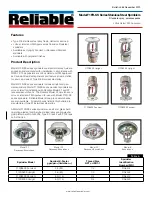
2
FCC ID JOFGMOR
IC: 5855A-GMOR
User Instructions
Introduction to Your Arctic Cat N-Touch Communication System:
Your snowmobile is equipped with a personal two-way radio communication system and intercom. This
will enable you to keep in touch with other riders and to easily talk with your passenger. The
communication system uses General Mobile Radio Service (GMRS) radio frequencies. GMRS is a land-
mobile radio service available for short-distance two-way communications to facilitate the activities of an
adult individual and his or her family members. The radio communication system on your snowmobile has
an output power of two watts. Distance performance is dependent on the terrain, weather conditions and
the antenna system.
This system requires professional installation by an authorized Arctic Cat dealership. Repair and service
should also be performed by your dealer.
Note: For optimal performance it is important to follow the Set-up Instructions included in this book.
Safety and General Information:
Read this information before using your radio for safe and efficient operation.
Transmit Procedure:
Your snowmobile has been equipped with a 2-way radio, meaning it can both transmit and receive radio
frequency (RF) signals. To reduce your exposure to the RF signals, it is recommended that you do not
transmit more than 50% of the time. By only using the transmission 50% of the time, you will be in
compliance with the general population and uncontrolled environment exposure standards.
Antenna Information:
The supplied antenna meets important product performance specifications and is an integral part of both
FCC and Industry Canada compliance. Changing or modifying the antenna in any way could potentially
damage the radio and violate FCC and/or Industry Canada regulations.
Avoid contact with the antenna when transmitting. This device meets the RF guideline FCC/OET 65 and
Canadian health code 6 for mobile devices, which assumes installation provides an antenna distance of at
least 20cm (8”) from users and others.
General Use Information:
Laws regarding the use of radios vary from state to state in the United States, and in Canada. Check the
laws in the areas where you ride, and obey them. It is recommended that you give full attention to riding
while using your radio. If the riding conditions dictate, pull over to make and receive transmissions.
Blasting and Potentially Explosive Areas:
Do not use your radio in blasting zones or potentially explosive areas. These areas are generally marked
with signs reading “ TURN OFF 2-WAY RADIO”, “BLASTING AREA”, “BLASTING ZONE” or
“POTENTIALLY EXPLOSIVE AREA”. Using your communication systems in these areas can interfere
with their operations.


























